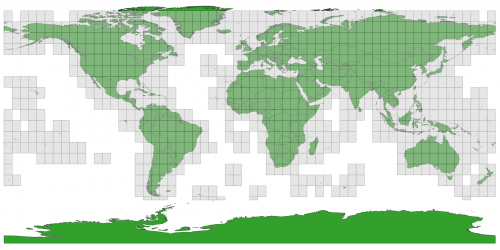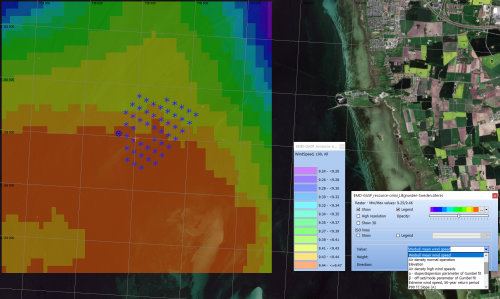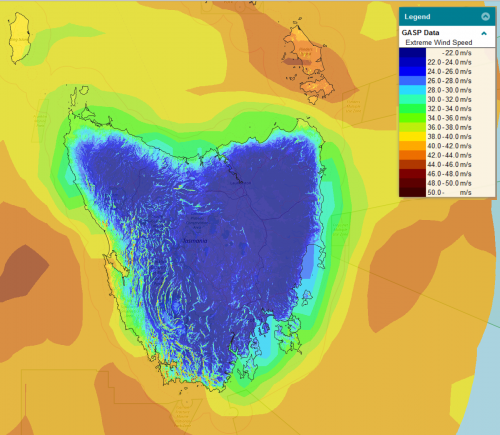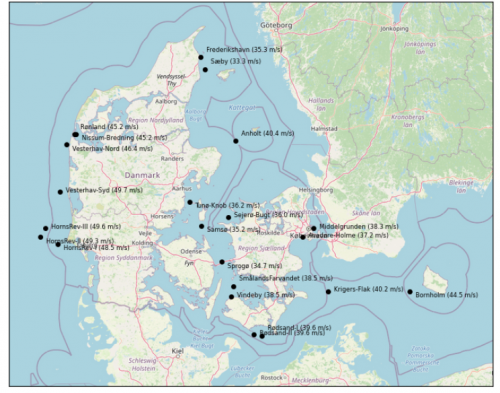GASP Global: Difference between revisions
mNo edit summary |
|||
| (54 intermediate revisions by 2 users not shown) | |||
| Line 1: | Line 1: | ||
[[Image:GASP_Coverage.png|thumb|right|500px|Spatial | [[Image:GASP_Coverage.png|thumb|right|500px|Spatial coverage of the GASP-Global datasets.]] | ||
[[Category: Online Data]][[Category: Atlas Data]][[Category: EMD-API]] | [[Category: Online Data]][[Category: Atlas Data]][[Category: EMD-API]] | ||
== Introduction == | == Introduction == | ||
"GASP Global" is short for "GASP 1.0 - Global of Atlas of Siting Parameters". It is a global atlas dataset with the following key features: | "GASP Global" is short for "GASP 1.0 - Global of Atlas of Siting Parameters". It is released with windPRO 3.5+ as a global atlas dataset with the following key features: | ||
* Global 250m wind resources, siting parameters & turbine design classification | * Global 250m wind resources, siting parameters & turbine design classification | ||
* Builds on | * Builds on DTU GWA (Global Wind Atlas) datasets and EMD's Load Response technology | ||
* A joint project by [https://www.emd.dk EMD] and [https://windenergy.dtu.dk/english DTU] | * A joint project by [https://www.emd.dk EMD] and [https://windenergy.dtu.dk/english DTU] | ||
| Line 15: | Line 15: | ||
** ''Vertical'': 50m, 100m and 150m as vertical levels | ** ''Vertical'': 50m, 100m and 150m as vertical levels | ||
* '''Data-type:''' [[:Category%3AAtlas_Data|Atlas]] | * '''Data-type:''' [[:Category%3AAtlas_Data|Atlas]] | ||
* '''Reference period:''' 10 years (2008-2017) | |||
* '''Coordinate system:''' Geographical coordinates (EPSG: 4326) in original data | * '''Coordinate system:''' Geographical coordinates (EPSG: 4326) in original data | ||
* '''Version:''' 1.0 | * '''Version:''' 1.0 | ||
== Availability from | == Validation and Usage Notes == | ||
* '''windPRO:''' | * '''How accurate is your resource prospecting based on GASP data in windPRO or windPROSPECTING? '''<br>We have prepared a small validation note - based on data from 241 high quality meteorological towers - that gives you a first hint on bias and uncertainty - read more - [https://help.emd.dk/mediawiki/images/f/fc/20210903_AccuracyGASPWindSpeeds.pdf HERE]. | ||
* '''Need turbulence intensity instead of the GASP windspeed standard deviation?''' <br>We have prepared a small pdf that describes how to convert from wind speed standard deviations to turbulence intensities - and how to use the two model parameters (A) and (B) to derive the turbulence intensity at any wind speed - read more - [https://help.emd.dk/mediawiki/images/4/43/20210806_TurbulenceFromGASPdata.pdf HERE]. | |||
* '''How is the GASP shear calculated?'''<br>The shear values from GASP are estimated using the DTU-LINCOM flow model. According to DTU, this was the best "local" source of shear given the models available during development of the GASP dataset (neutral atmospheric stability assumed, so the reported GASP shear is representative for "higher" wind speeds). Another option would have been to estimate the shear using the WAsP model (with default or custom-specified atmospheric stability parameters). However, if you are interested in "WAsP-shear" values, it is perfectly possible to derive those directly (but manually) from existing GASP annual average wind speeds in 50m, 100m and 150m [parameter: wsp]. The "WAsP-shear" is currently not included in the GAsP dataset version 1.0, but under consideration for a future dataset update. | |||
== Availability from EMD's software == | |||
[[Image:GASP_WindResources_WindPRO.png|thumb|right|500px|Wind Resouces in 100m height at Lillgrunden, Sweden. GASP data accessed through windPRO 3.5.]][[Image:GASP_Extremes_WindPROSPECTING.png|thumb|right|500px|50yr Extreme Wind Speeds in 100m height at Tasmania, Australia. GASP data accessed through http://www.windPROSPECTING.com platform.]][[Image:GASP_Extremes_EMDAPI.png|thumb|right|500px|50yr Extreme Wind Speeds in 100m height at Danish Offshore Wind Farms. GASP data accessed through the EMD-API platform, http://api.emd.dk]] | |||
* '''windPRO:''' In 'Data' menu click 'Siting parameters (GASP etc)' to access the download tool. Data is loaded into a result layer with a .siteres file acting as the data-container. | |||
** The .siteres file can be used in PARK, Site Compliance, Load Response and Optimization calculations. | |||
* '''windPROSPECTING:''' GASP data is available through the data-tab named 'Site-prospecting'. Free access to windPROSPECTING - [https://www.windprospecting.com here]. | * '''windPROSPECTING:''' GASP data is available through the data-tab named 'Site-prospecting'. Free access to windPROSPECTING - [https://www.windprospecting.com here]. | ||
** windprospecting offers spatial view of omnidirectinal parameters and detailed point-data with directional results and statistics. | |||
* '''EMD-API:''' Read more at the dedicated wiki-page for our Global Atlas Data Services - [[EMD-API_-_Global_Atlas_Services|here]]. If you are accessing the GASP data from within the EMD-API, you will use the parameter group-names in order to request specific data-packages [resource-omni, resource-sector, siting-extremes, siting-fatigue-omni, siting-fatigue-sector, turbine-fatigue, turbine-fatigue-recommend, turbine-extreme, turbine-extreme-recommend]. | * '''EMD-API:''' Read more at the dedicated wiki-page for our Global Atlas Data Services - [[EMD-API_-_Global_Atlas_Services|here]]. If you are accessing the GASP data from within the EMD-API, you will use the parameter group-names in order to request specific data-packages [resource-omni, resource-sector, siting-extremes, siting-fatigue-omni, siting-fatigue-sector, turbine-fatigue, turbine-fatigue-recommend, turbine-extreme, turbine-extreme-recommend]. | ||
== Parameters and Dimensions == | == Parameters and Dimensions == | ||
As seen from the tables below, a very wide range of omnidirectional and sectorwise parameters are available from | As seen from the tables below, a very wide range of omnidirectional and sectorwise parameters are available from GASP. These parameters are divided into four main categories: | ||
* Wind Resources / Atmospheric Parameters | |||
* Siting Parameters – Fatigue | |||
* Siting Parameters – Extremes | |||
* Turbine Design Classification - with recommended turbine class. 3 separate aeroelastic models are used as representative for the 3 heights | |||
** 50m: WindPACT 1.5MW | |||
** 100m: NREL 5MW | |||
** 150m: DTU 10MW | |||
The tables below provides an overview of all parameters available and at which dimensions that they are available. We have used the following dimensions for the GASP parameters: The first four (longitude, latitude, height and sector) are used for the basic parameters; the last three (ws_class, iec_class and turbine_component) are used for the turbine design classification - and are releated to the IEC61400-1 code and the aeroelastic load model. Please note that not all dimensions are relevant or used for every GASP parameter. | The tables below provides an overview of all parameters available and at which dimensions that they are available. We have used the following dimensions for the GASP parameters: The first four (longitude, latitude, height and sector) are used for the basic parameters; the last three (ws_class, iec_class and turbine_component) are used for the turbine design classification - and are releated to the IEC61400-1 code and the aeroelastic load model. Please note that not all dimensions are relevant or used for every GASP parameter. | ||
{| class="wikitable" | {| class="wikitable" | ||
| Line 73: | Line 85: | ||
|} | |} | ||
== Parameters: Wind | == Parameters: Wind Resource == | ||
The two tables below show the GASP parameters for wind | The two tables below show the GASP parameters for wind resource data divided in omnidirectional data [resource-omni] and sectorwise data [resource-sector]. | ||
{| class="wikitable" | {| class="wikitable" | ||
| Line 147: | Line 159: | ||
|- | |- | ||
|elevation | |elevation | ||
| | |Terrain Elevation | ||
| | |m | ||
|lon, lat | |lon, lat | ||
|} | |} | ||
| Line 208: | Line 220: | ||
|lon, lat, h | |lon, lat, h | ||
|- | |- | ||
|sigma_P90A | |sigma_P90A<ref name="SigmaTurbulence">Note: This parameter is windspeed standard deviation. It can be converted into a turbulence intensity - see more at the usage note section above. </ref> | ||
|Turbulence slope parameter from IEC 61400-1 (ed4) – P90 | |Turbulence slope parameter from IEC 61400-1 (ed4) – P90 | ||
| | | | ||
|lon, lat, h | |lon, lat, h | ||
|- | |- | ||
|sigma_P90B | |sigma_P90B<ref name="SigmaTurbulence" /> | ||
|Turbulence offset parameter from IEC 61400-1 (ed4) – P90 | |Turbulence offset parameter from IEC 61400-1 (ed4) – P90 | ||
|m/s | |m/s | ||
| Line 246: | Line 258: | ||
|lon, lat, h, s | |lon, lat, h, s | ||
|- | |- | ||
|sigma_meanA | |sigma_meanA<ref name="SigmaTurbulence" /> | ||
|Turbulence slope parameter from IEC 61400-1 (ed4) – Mean | |Turbulence slope parameter from IEC 61400-1 (ed4) – Mean | ||
|m/s | |m/s | ||
|lon, lat, h, s | |lon, lat, h, s | ||
|- | |- | ||
|sigma_meanB | |sigma_meanB<ref name="SigmaTurbulence" /> | ||
|Turbulence offset parameter from IEC 61400-1 (ed4) – Mean | |Turbulence offset parameter from IEC 61400-1 (ed4) – Mean | ||
|m/s | |m/s | ||
|lon, lat, h, s | |lon, lat, h, s | ||
|- | |- | ||
|sigma_P90A | |sigma_P90A<ref name="SigmaTurbulence" /> | ||
|Turbulence slope parameter from IEC 61400-1 (ed4) – P90 | |Turbulence slope parameter from IEC 61400-1 (ed4) – P90 | ||
| | | | ||
|lon, lat, h, s | |lon, lat, h, s | ||
|- | |- | ||
|sigma_P90B | |sigma_P90B<ref name="SigmaTurbulence" /> | ||
|Turbulence offset parameter from IEC 61400-1 (ed4) – P90 | |Turbulence offset parameter from IEC 61400-1 (ed4) – P90 | ||
|m/s | |m/s | ||
| Line 269: | Line 281: | ||
== Parameters: Turbine Design – Loads == | == Parameters: Turbine Design – Loads == | ||
The four tables below show the GASP parameters for the turbine design classification. | The four tables below show the GASP parameters for the turbine design classification. The two main groups are fatigue and extreme load cases, divided into four data-groups so requests is possible for turbine load indexes and iec class recommendations: [turbine-fatigue, turbine-fatigue-recommend, turbine-extreme, turbine-extreme-recommend]. | ||
{| class="wikitable" | {| class="wikitable" | ||
| Line 340: | Line 352: | ||
!Unit | !Unit | ||
!Dimensions | !Dimensions | ||
|- | |- | ||
|ulsidx | |ulsidx | ||
| Line 373: | Line 380: | ||
== License and Attribution == | == License and Attribution == | ||
The data is available | The data is available through a [https://creativecommons.org/licenses/by/4.0/ Creative commons 4.0 by attribution license] (CC BY 4.0). <br>Please accept the license conditions and use a proper attribution when using this dataset, such as: | ||
<pre> | <pre> | ||
GASP 1.0 | GASP 1.0: Global Atlas of Siting Parameters 1.0 by EMD and DTU, is a free dataset accessible via | ||
EMD (windprospecting.com, windPRO & EMD-API) and DTU (globalwindatlas.info, science.globalwindatlas.info & data.dtu.dk). | |||
License: CC-BY-4.0 | |||
</pre> | </pre> | ||
== Acknowledgement == | == Acknowledgement == | ||
* GASP is the result of a BIG collective effort by many people at: EMD International A/S & DTU Wind Energy, with overall project manager Xiaoli Larsén (DTU) | |||
* Develoment and integration of this dataset into EMD services was done through the [https://windenergy.dtu.dk/english/research/research-projects/gasp GASP project] which is co-funded by the [https://ens.dk/en/our-responsibilities/research-development/eudp EUDP] and the Danish Energy Agency | * Develoment and integration of this dataset into EMD services was done through the [https://windenergy.dtu.dk/english/research/research-projects/gasp GASP project] which is co-funded by the [https://ens.dk/en/our-responsibilities/research-development/eudp EUDP] and the Danish Energy Agency | ||
== External Links == | == External Links & References == | ||
* GASP Project Home-Page at DTU - [https:// | * GASP Project Home-Page at DTU - [https://wind.dtu.dk/projects/Research-Projects/Completed-projects/GASP here] | ||
* An open-access, peer-reviewed paper is available from the Wind Energy Journal: <br>[https://onlinelibrary.wiley.com/doi/10.1002/we.2771 The Global Atlas for Siting Parameters project: Extreme wind, turbulence, and turbine classes] by Xiaoli Guo Larsén, Neil Davis, Ásta Hannesdóttir, Mark Kelly, Lasse Svenningsen, René Slot, Marc Imberger, Bjarke Tobias Olsen and. Rogier Floors. | |||
* GASP data is available from the Global Wind Atlas App (from version 3.3) - [https://globalwindatlas.info/en here] | |||
* GASP data from DTU data portal - [https://data.dtu.dk/articles/dataset/Global_Atlas_of_Siting_Parameters_V1/14753349 here] | |||
== Footnotes == | |||
<references/> | |||
Latest revision as of 12:05, 21 May 2024

Introduction
"GASP Global" is short for "GASP 1.0 - Global of Atlas of Siting Parameters". It is released with windPRO 3.5+ as a global atlas dataset with the following key features:
- Global 250m wind resources, siting parameters & turbine design classification
- Builds on DTU GWA (Global Wind Atlas) datasets and EMD's Load Response technology
- A joint project by EMD and DTU
Dataset Overview
- Spatial coverage:
- Onshore: Near global (all land areas from N80 to S58)
- Offshore: Areas are covered up to 200 km from the coastline
- Resolution:
- Horizontal: 250m in grid resolution
- Vertical: 50m, 100m and 150m as vertical levels
- Data-type: Atlas
- Reference period: 10 years (2008-2017)
- Coordinate system: Geographical coordinates (EPSG: 4326) in original data
- Version: 1.0
Validation and Usage Notes
- How accurate is your resource prospecting based on GASP data in windPRO or windPROSPECTING?
We have prepared a small validation note - based on data from 241 high quality meteorological towers - that gives you a first hint on bias and uncertainty - read more - HERE. - Need turbulence intensity instead of the GASP windspeed standard deviation?
We have prepared a small pdf that describes how to convert from wind speed standard deviations to turbulence intensities - and how to use the two model parameters (A) and (B) to derive the turbulence intensity at any wind speed - read more - HERE. - How is the GASP shear calculated?
The shear values from GASP are estimated using the DTU-LINCOM flow model. According to DTU, this was the best "local" source of shear given the models available during development of the GASP dataset (neutral atmospheric stability assumed, so the reported GASP shear is representative for "higher" wind speeds). Another option would have been to estimate the shear using the WAsP model (with default or custom-specified atmospheric stability parameters). However, if you are interested in "WAsP-shear" values, it is perfectly possible to derive those directly (but manually) from existing GASP annual average wind speeds in 50m, 100m and 150m [parameter: wsp]. The "WAsP-shear" is currently not included in the GAsP dataset version 1.0, but under consideration for a future dataset update.
Availability from EMD's software



- windPRO: In 'Data' menu click 'Siting parameters (GASP etc)' to access the download tool. Data is loaded into a result layer with a .siteres file acting as the data-container.
- The .siteres file can be used in PARK, Site Compliance, Load Response and Optimization calculations.
- windPROSPECTING: GASP data is available through the data-tab named 'Site-prospecting'. Free access to windPROSPECTING - here.
- windprospecting offers spatial view of omnidirectinal parameters and detailed point-data with directional results and statistics.
- EMD-API: Read more at the dedicated wiki-page for our Global Atlas Data Services - here. If you are accessing the GASP data from within the EMD-API, you will use the parameter group-names in order to request specific data-packages [resource-omni, resource-sector, siting-extremes, siting-fatigue-omni, siting-fatigue-sector, turbine-fatigue, turbine-fatigue-recommend, turbine-extreme, turbine-extreme-recommend].
Parameters and Dimensions
As seen from the tables below, a very wide range of omnidirectional and sectorwise parameters are available from GASP. These parameters are divided into four main categories:
- Wind Resources / Atmospheric Parameters
- Siting Parameters – Fatigue
- Siting Parameters – Extremes
- Turbine Design Classification - with recommended turbine class. 3 separate aeroelastic models are used as representative for the 3 heights
- 50m: WindPACT 1.5MW
- 100m: NREL 5MW
- 150m: DTU 10MW
The tables below provides an overview of all parameters available and at which dimensions that they are available. We have used the following dimensions for the GASP parameters: The first four (longitude, latitude, height and sector) are used for the basic parameters; the last three (ws_class, iec_class and turbine_component) are used for the turbine design classification - and are releated to the IEC61400-1 code and the aeroelastic load model. Please note that not all dimensions are relevant or used for every GASP parameter.
| Dimension | Abbreviation | Unit | Range |
|---|---|---|---|
| longitude | lon | deg | 180 to -180 |
| latitude | lat | deg | 90 to -90 |
| height | h | m | 50,100,150 |
| sector | s | deg | 0,30,...,330 |
| ws_class | wcl | I,II,III,T | |
| iec_class | iecc | IA+, IA,...IIIC | |
| turbine_component | tc | 0,1,2,3 |
Parameters: Wind Resource
The two tables below show the GASP parameters for wind resource data divided in omnidirectional data [resource-omni] and sectorwise data [resource-sector].
| Variable | Description | Unit | Dimensions |
|---|---|---|---|
| weib_A | Wind distribution: A (Scale) parameter in Weibull distribution | m/s | lon, lat, h |
| weib_k | Wind distribution: k (shape) parameter in Weibull distribution | lon, lat, h | |
| wsp | Wind speed - annual average | m/s | lon, lat, h |
| wpd | Wind power density – annual average | W/m2 | lon, lat, h |
| air_dens | Air density (annual mean/average) | kg/m3 | lon, lat, h |
| Variable | Description | Unit | Dimensions |
|---|---|---|---|
| weib_A | Wind distribution: A (Scale) parameter in Weibull distribution | m/s | lon, lat, h, s |
| weib_k | Wind distribution: k (shape) parameter in Weibull distribution | lon, lat, h, s | |
| sector_freq | Wind distribution: Sector frequency | lon, lat, h, s | |
| wsp | Wind speed - annual average | m/s | lon, lat, h, s |
| wpd | Wind power density – annual average | W/m2 | lon, lat, h, s |
| air_dens | Air density (annual mean/average) | kg/m3 | lon, lat, h |
| elevation | Terrain Elevation | m | lon, lat |
Parameters: Siting Classification - Wind Extremes
The table below shows the GASP parameters for the extreme event data [siting-extremes]. Please note that this extreme data is only available as omnidirectional parameters.
| Variable | Description | Unit | Dimensions |
|---|---|---|---|
| air_dens_p98 | Air density at 98th percentile of wind speed | kg/m3 | lon, lat, h |
| wsp_50yr | 50yr extreme wind speed: Average | m/s | lon, lat, h |
| gumbel_alpha | 50yr extreme wind speed: Gumbel distribution – alpha parameter | m/s | lon, lat, h |
| gumbel_beta | 50yr extreme wind speed: Gumbel distribution – beta parameter | m/s | lon, lat, h |
Parameters: Siting Classification - Wind Fatigue Parameters
The two tables below show the GASP parameters for the siting-fatigue parameters - given either omnidirectional or sectorwise data-requests [siting-fatigue-omni, siting-fatigue-sector].
| Variable | Description | Unit | Dimensions |
|---|---|---|---|
| shear_exp | Wind shear exponent (calculated using LINCOM model) - Mean | lon, lat, h | |
| flow_inc | Flow inclination (calculated using LINCOM model) | deg | lon, lat, h |
| terrain_ic | Terrain complexity as defined in IEC 61400-1 standard (ed 4) | lon, lat, h | |
| sigma_P90A[1] | Turbulence slope parameter from IEC 61400-1 (ed4) – P90 | lon, lat, h | |
| sigma_P90B[1] | Turbulence offset parameter from IEC 61400-1 (ed4) – P90 | m/s | lon, lat, h |
| sigma_P90U15 | Turbulence P90 at a fixed windspeed of 15 m/s | m/s | lon, lat, h |
| air_dens | Air density (annual mean/average) | kg/m3 | lon, lat, h |
| Variable | Description | Unit | Dimensions |
|---|---|---|---|
| shear_exp | Wind shear exponent (calculated using LINCOM model) - Mean | lon, lat, h, s | |
| flow_inc | Flow inclination (calculated using LINCOM model) | deg | lon, lat, h, s |
| sigma_meanA[1] | Turbulence slope parameter from IEC 61400-1 (ed4) – Mean | m/s | lon, lat, h, s |
| sigma_meanB[1] | Turbulence offset parameter from IEC 61400-1 (ed4) – Mean | m/s | lon, lat, h, s |
| sigma_P90A[1] | Turbulence slope parameter from IEC 61400-1 (ed4) – P90 | lon, lat, h, s | |
| sigma_P90B[1] | Turbulence offset parameter from IEC 61400-1 (ed4) – P90 | m/s | lon, lat, h, s |
Parameters: Turbine Design – Loads
The four tables below show the GASP parameters for the turbine design classification. The two main groups are fatigue and extreme load cases, divided into four data-groups so requests is possible for turbine load indexes and iec class recommendations: [turbine-fatigue, turbine-fatigue-recommend, turbine-extreme, turbine-extreme-recommend].
| Variable | Description | Unit | Dimensions |
|---|---|---|---|
| flsidx | Load index for the fatigue limit state | % | lon, lat, h, iecc, tc |
| flsidx_w | Load load index for the fatigue limit state with wakes | % | lon, lat, h, iecc, tc |
| tc_woehler | Turbine component (tc): Wöhler exponent used | lon, lat, h, iecc, tc | |
| tc_name | Turbine component (tc): Name | lon, lat, h, iecc, tc | |
| tc_sensor | Turbine component (tc): Sensor name | lon, lat, h, iecc, tc |
| Variable | Description | Unit | Dimensions |
|---|---|---|---|
| iecr_fls_id | IEC Class Recommendation – fatigue limit state (FLS) - id | lon, lat, h | |
| iecr_fls_txt | IEC Class Recommendation – fatigue limit state (FLS) - text | lon, lat, h | |
| iecr_flsw_id | IEC Recommendation (with wakes) – fatigue limit state (FLS) - id | lon, lat, h | |
| iecr_flsw_txt | IEC Recommendation (with wakes) – fatigue limit state (FLS) - text | lon, lat, h |
| Variable | Description | Unit | Dimensions |
|---|---|---|---|
| ulsidx | Design load index for ultimate limit state (ULS) | % | lon, lat, h, wcl |
| Variable | Description | Unit | Dimensions |
|---|---|---|---|
| iecr_uls_id | Design load index for ultimate limit state (ULS) | lon, lat, h | |
| iecr_uls_txt | IEC Class Recommendation – ultimate limit state (ULS) – text | lon, lat, h |
License and Attribution
The data is available through a Creative commons 4.0 by attribution license (CC BY 4.0).
Please accept the license conditions and use a proper attribution when using this dataset, such as:
GASP 1.0: Global Atlas of Siting Parameters 1.0 by EMD and DTU, is a free dataset accessible via EMD (windprospecting.com, windPRO & EMD-API) and DTU (globalwindatlas.info, science.globalwindatlas.info & data.dtu.dk). License: CC-BY-4.0
Acknowledgement
- GASP is the result of a BIG collective effort by many people at: EMD International A/S & DTU Wind Energy, with overall project manager Xiaoli Larsén (DTU)
- Develoment and integration of this dataset into EMD services was done through the GASP project which is co-funded by the EUDP and the Danish Energy Agency
External Links & References
- GASP Project Home-Page at DTU - here
- An open-access, peer-reviewed paper is available from the Wind Energy Journal:
The Global Atlas for Siting Parameters project: Extreme wind, turbulence, and turbine classes by Xiaoli Guo Larsén, Neil Davis, Ásta Hannesdóttir, Mark Kelly, Lasse Svenningsen, René Slot, Marc Imberger, Bjarke Tobias Olsen and. Rogier Floors. - GASP data is available from the Global Wind Atlas App (from version 3.3) - here
- GASP data from DTU data portal - here